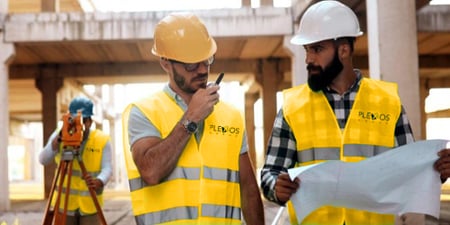3 min read
Healthy and Sustainable Infrastructure for All: To Make Environmental Justice Commitments a Reality, Involve Impacted Communities
Plexos Group
14 April 2023

In 2021, President Joe Biden made a historic commitment to environmental justice when he signed the $1.2 Trillion Infrastructure Investment and Jobs Act (IIJA). Together with the Build Back Better Framework, the BIL is structured to ensure that the needs of vulnerable or marginalized communities that have suffered environmental harms - from legacy pollution to a lack of clean resources, fractured community access, and inadequate public transportation - are central to the transformative infrastructure programs now happening across the country. With its focus on climate resilience, clean drinking water, public transportation, power, broadband, railroads, and roads and bridges, the IIJA marks a major step toward meaningful change for future generations.
But from my experience collaborating with Congress and governors on environmental justice and racial disparity issues since the early 1990s, our best chance of making the commitments of the IIJA a reality is through a planning and implementation process at both the state and local levels that involves affected communities at every step. Only then will historically vulnerable or marginalized communities be able to gain fair and equitable access to infrastructure that supports long-term public health, economic sustainability, and resilience to climate change.
A well-planned and executed infrastructure program that prioritizes environmental justice hinges on several key principles:
engaging affected communities
Use community input to make decisions. Invite participation and build trust by tailoring outreach specifically to the impacted community's needs and concerns. For example, after Hurricane Katrina, while working with the Louisiana Recovery Authority, holding more than 200 meetings in affected parishes spurred discussions that ultimately led to meaningful policy changes that improved access to and distribution of funding. But community involvement doesn’t stop there. Plan to hire local contractors, engineers, and other providers, especially Minority and Women-owned Businesses (M/WBE) who’ve experienced the area’s challenges first-hand and can contribute to tangible approaches to addressing those issues.
PromotING TRANSPARENCY
Frequent meetings with program stakeholders are essential to meeting long-term goals and measuring success. Use those meetings to report on key performance indicators and milestones while providing transparency and accountability about fair and equitable resource distribution.
RemediatING environmental harm
In my own work managing an environmental justice panel in Calcasieu Parish, Louisiana, in the early 1990s and advising major petrochemical companies on racial disparity issues, I studied the impacts of environmental hazards on the communities surrounding Mossville, Louisiana, and briefed then Energy Secretary Bill Richardson on strategies related to protecting citizens through green space for those living in the vicinity of industrial complexes. Projects that move families out of harm’s way, projects that remediate environmental harm, and those built in line with better environmental stewardship principles can ensure that people are safe and that our infrastructure supports healthy long-term growth.
Identify projects that prioritize environmental protection and remediation, particularly in areas known to have suffered the effects of exposure to pollution from toxic substances or hazardous waste. Focus on fixing known air and water pollutant sources and cleaning up contamination, while avoiding any further harm that could result from construction work.
pLANNING for climate resilience
Help communities prepare to withstand future disasters. Any disaster mitigation efforts should center on infrastructure improvements tailored to specific geographic challenges and known flooding hazards. Analyze all land-use planning measures to ensure those plans encompass long-term sustainability and access to public resources. Work directly with communities to develop education and training resources for disaster preparedness. Evaluate building codes and improvements in building materials to implement new standards, when appropriate, that will support stronger, safer housing and public infrastructure.
expandING green infrastructure and sustainable transportation
Green infrastructure can help mitigate the effects of climate change by reducing temperatures in urban centers while improving air quality and recapturing stormwater. For example, parks intentionally designed to drain off and contain stormwater have multifunctional benefits. These community amenities provide recreational and community gathering spaces but also help communities better manage water. Permeable paved surfaces designed to absorb and slowly drain water runoff to soils below can transform parking lots and roadways into rain and runoff management systems that reduce standing water, improve water quality, and minimize erosion, all of which can improve safety. Meanwhile, investing in public transit systems and alternative modes of transportation, such as biking and walking can improve air quality and the quality of public health.
About paul rainwater
 Paul Rainwater is among the nation’s most experienced disaster recovery funding professionals. Local, state, and federal government agencies including the HUD National Disaster Recovery Unit - as well as the executive branch - rely on his collaboration to develop action plans, policies, and deployment strategies that promote environmental justice by prioritizing equitable rebuilding and development for historically vulnerable communities. Read more about Paul here.
Paul Rainwater is among the nation’s most experienced disaster recovery funding professionals. Local, state, and federal government agencies including the HUD National Disaster Recovery Unit - as well as the executive branch - rely on his collaboration to develop action plans, policies, and deployment strategies that promote environmental justice by prioritizing equitable rebuilding and development for historically vulnerable communities. Read more about Paul here.



-1.jpg?width=450&name=1600%20x%20900%20-%20Plexos%20(13)-1.jpg)
